This absolutely
pristine capital bone surgery set, which is marked U.S. Army Hospital
Department, was found at an estate sale in Pennsylvania. The set,
which is in almost unused condition, and is 100% complete, was found sitting
on a lamp table, covered by a piece of cloth, with a lamp sitting on top of
the case. No other history is known about the set or its owners
but the set has never been in any other hands than the original owners or
family. The set was
obtained at auction
2-12-2006 in New York state after being removed from the family house in
Pennsylvania.
Hermann Hernstein surgical instruments, N.Y.:
1843:
3 Chambers
1844:
Elizabeth cor. Hester
1845-48: 7 Hague
1850:
no listing
1851-52: 68 Duane
1853-54: 81 Duane
1855-57: 81 Duane and 393 Broadway
1858:
81 Duane, 131 Mercer, and 393 Broadway 1859-61: 131 Mercer and 393 Broadway
Hermann Hernstein & Son
(Hermann and Albert L. Hernstein) 1862-65: 131 Mercer and 393 Broadway
Hermann
Hernstein & Son & Co. 1865:
2 Liberty and 393 Broadway
Hermann Hernstein & Co. 1866-67:
2 Liberty and 393 Broadway
The set by NY. maker, H.
Hernstein & Son, (1861-1864) is in a brass bound mahogany case, with bilateral military
latches, which measures 17 x 7.75 x 3.75 in. The brass plate
(escutcheon) on the top is
engraved "U. S. A. Hosp. Dept.". The three tiered set has over 36 instruments, four of which
are marked "U. S. A. Hosp. Dep't." The oil-dyed blue velvet lined set contains
instruments for major bone surgery, but no instrument for bullet removal or trocar for
bladder relief. Based on other similar sets in this and other collections, it can
be assumed this was a specialty set intended to be used in a military
hospital for bone surgery and resection by a senior medical officer.
Interesting features:
angled brass cover to hold amputation knives in place, which is usually
associated with later sets; blue velvet lining instead of the typical red
interior seen in many Civil War sets, but blue was common in Tiemann and
Hernstein sets made immediately prior to the Civil War. Unlike sets
from some makers, there are no re-enforcing screws in the top of the case,
but there are brass corner brackets. The most important fact is this
set is a window into the way it left the factory and was given to a surgeon.
According to
Edmonson's research, toward the end of the War, Hernstein was in possession
of a number of surgery sets made for the military. It is not known for
sure if these sets were sold on the civilian market or released to the
military. The fact this set is engraved for the U. S. Army Hospital
Department would suggest it was in the possession of the Army Hospital
Department, but apparently was only used sparingly. The only real evidence
of use is indentations on the chisel mallet, which would definitely indicate
use at some point. But more than likely this set was a late
hospital arrival and saw little use.
There are several
photos of the tourniquet because the tourniquet with both strap and brass
frame is in unused condition as it came from the factory. It's
interesting how it is wrapped and pined. The tourniquet is marked
'Hernstein'. This is just one example of many in this set which
allows us to see how these military sets left the factory. Another
example is found in the needle compartment which appears untouched as the
needles are still tied together with a piece of silver wire, the bone wax is
still wrapped in tissue, and all needles are still coated with an oil.
This set is perhaps in
the best condition and the most complete large military set to ever be found.
Extensive analysis of this set will help you understand the importance of
this 'factory fresh' Civil War Union purchased military set.
Click on
photos to enlarge

Mahogany, brass
bound case with original varnish and name plate. The red
cloth bottom cover is still in place |

Set with
removable tray in front |
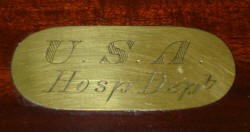
"U. S. Army
Hospital Department" engraved and varnished brass plate embedded
in the top
|
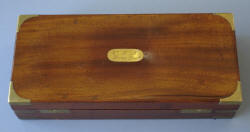
No screws in the top
and brass corners |
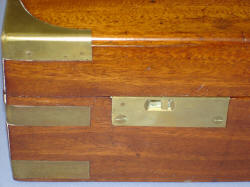
Military style sliding
latch |
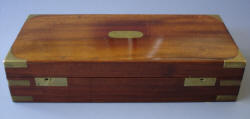
Bilateral
military latches, no key |
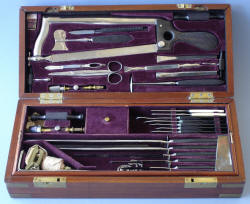
Partition removed |
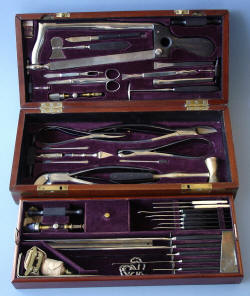
All three tiers with tray removed |
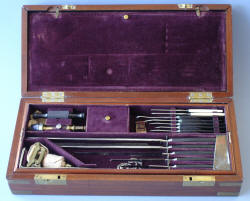
Partition in place on initial
opening |
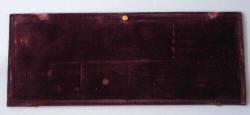
Partition cover
for upper tray |
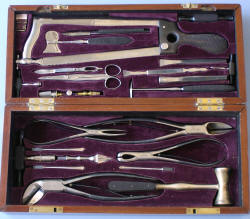
Partition and tray
removed |

Hernstein logo and
embossed eagle on the partition |
|
|

Removable tray |
|
|
|
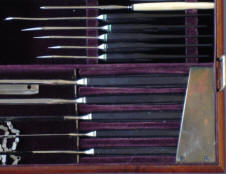
Retaining brass
plate over knives |
|
|
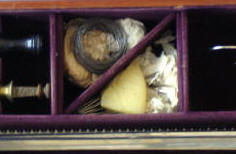
Cover removed
from needle box
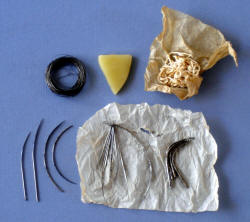
Contents of needle box: silver wire used for
stabilizing a
bone resection, bone wax to stop bleeding, silk
thread, suture needles, heavy suture screw-on-tips for
Mott's ivory aneurism handle,
original packing paper. The needles and
heavy suture set were tied through the eyes with
soft wire at the factory.
See an
article on
suture
needles and suturing
|

Scalpels,
tenaculum, aneurism needles on a wire tie with ivory handled
Mott's aneurism suture set |
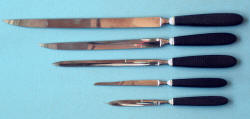
Set of Liston's amputation
knives, including catlin, and metacarpal saw |

Contents of
removable tray
|


Hernstein and Son maker mark |
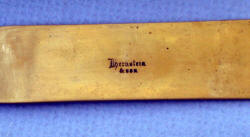
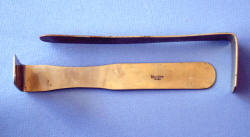
German silver muscle or tissue retractors with 'Hernstein
and Son' mark |
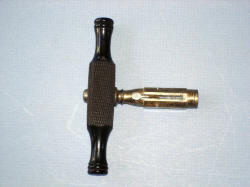
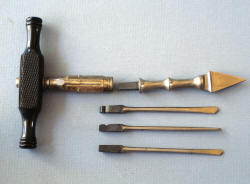
Extremely unusual bone drill with locking mechanism
on the shaft. The custom ebonized wood handle is one
of three in this set.
See
an article on
bone drills similar to this one by Wyeth and
Smith
Osteotome bone drills for un-united and oblique
fractures, for passing silver sutures, clearing out
carious cavities and letting out pus. (Tiemann, page
109)
|
| |
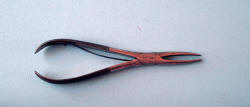 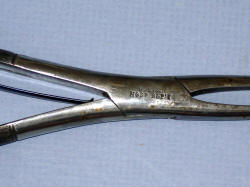 |
There are three
types of heavy bone ronguers shown and one bone holding forceps
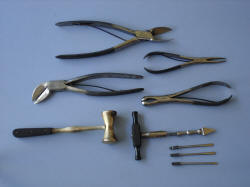
All these heavy duty
forceps and ronguers are in the lower part of the case.
Note the U.S.A Hosp. Dept. markings only found on military
issued instruments |
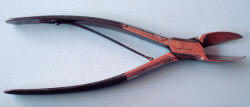  |
 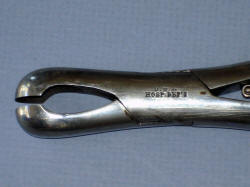 |
 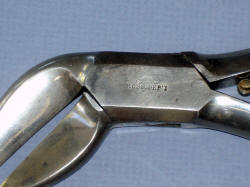 |
| |
|
|
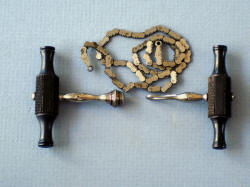
Bone chain saw
with detach handles
|
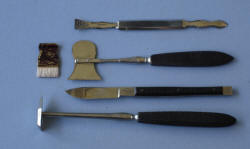
Painted brass
bone brush, and other cranial surgery (trepanning) instruments:
Hey saw, raspatory, elevator |

Contents of upper
tray, including olive forceps, trephine, elevator, raspatory,
scalpel, spare saw blade, Hey saw, scissors, and chisels |
 |
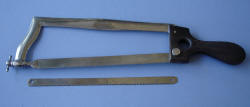 |
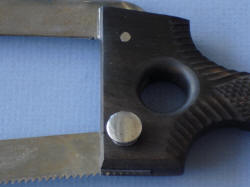 |
|
Turn buckle to
tighten saw blade |
Open frame saw
and spare blade |
Knurled nut to
hold saw blade |
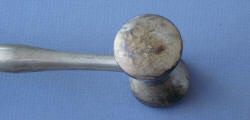
Chisel mallet
showing use dents |
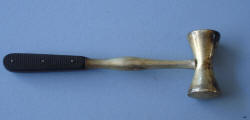
Chisel mallet |
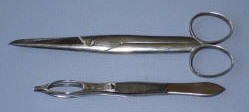
Oive Artery forceps
Straight scissor |
|
|
|
|
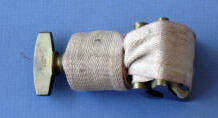 |
Pinned end of
strap is factory fresh
'Hernstein' marked
Petit's spiral tourniquet, note wrapping technique.
Very rare to see any tourniquet which has not been opened |
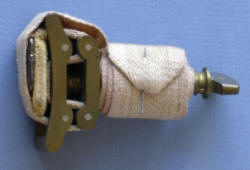 |
|
|
|
|
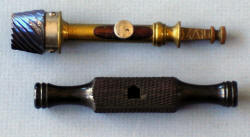
The Galt trephine
cutting blade is blued |
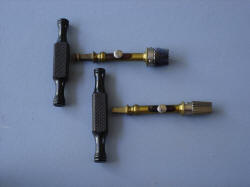
Two Galt type
trephines, note the larger one is blued and the smaller one is
not. There are two custom handles |
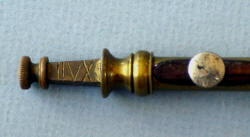
Note the IIVX
marking on the shaft |
Read an analysis of
another Civil War set with unusual history and how it was determined